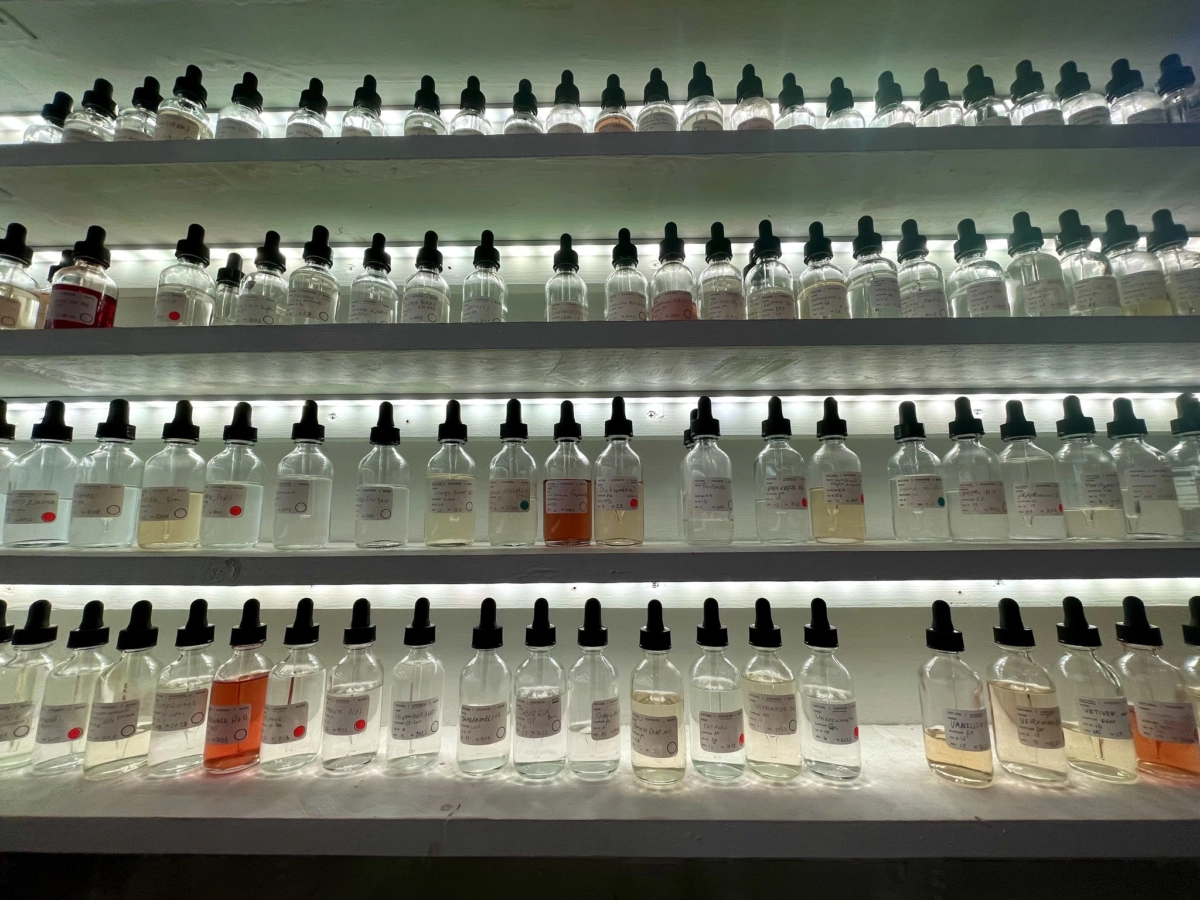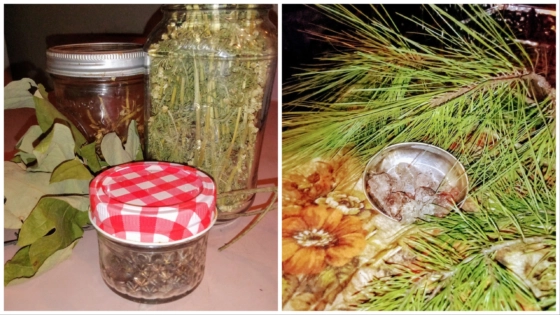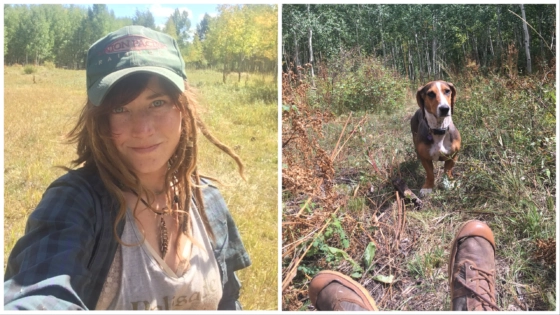Many perfumes and fragrances are unsustainably extracted from plants and animals or made from synthetic chemicals. I wanted to find another way.

My contraption hisses and bubbles. I feel like a mad scientist. The air is filled with a scent so uplifting that I’m practically floating. Finally, a single drop of liquid lands in the bottom of the glass. My first attempt at steam distillation is working and I’m bobbing with excitement.
My whimsical project began when I was given an old pressure cooker, which I converted into a still with the addition of a meat thermometer and copper refrigerator line. I then collected a massive quantity of Hoary mountain mint, a tall, sprightly plant that grows along the roadsides near my Southern Appalachian home. This took a whole morning, notwithstanding the time spent talking with a neighbor who passed by; when I explained what I was doing with the prodigious quantity of plant matter I had collected, he regaled me with tales of moonshiners who had run their stills in the mountains.
Unlike distilling liquor, distilling essential oil for personal use is legal. But like the moonshiners before me, I, too, was trying to capture lighting in a bottle. At the end of the hot summer’s day, my work had yielded a small jar of mint-infused water known as a hydrosol and just a few drops of essential oil. The scent was so refreshing that the process seemed worth it.
I didn’t start out a perfume-ophile. I’d been put off of commercial offerings because the smell of Axe body spray and Victoria’s Secret perfume had floated down the halls of my high school more strongly than teenage hormones. But the purchase of a bottle of essential oil led to some incense sticks and, eventually, I found myself in the health and beauty aisle of my local co-op sniffing aromatherapy blends and solid perfumes.
Finally, I ventured into professional perfumes. This selection provided complexity, depth and subtlety that the commercial offerings of my youth lacked. But, as I shopped, I encountered a quandary familiar to eaters: “How do I choose sustainably and ethically produced products?”

A selection of aromatics including yarrow, sassafras and sweet clover (left); pine resin and boughs (right). (Photos: Melissa Julia)
In essence, the debate about sustainability in perfume boils down to this: It takes a massive amount of material to produce essential oils, and the most prized materials are often threatened plants and animal products. On the flip side, synthetic chemical ingredients are often untested, derived from petroleum byproducts and can contain phthalates and PFAs, which many folks eschew due to health concerns. Companies are not required to provide ingredient labels, so making informed choices is especially difficult.
To shed some light on this topic, I spoke with Dr. Anjanette DeCarlo, who serves as chief sustainability scientist at the Aromatic Plant Research Center, where she conducts field research and ecological supply chain analysis on aromatic species. Much of her work has centered around the chronically overharvested Frankincense tree, which grows in the Middle East, Africa and India. When ingredients are harvested from developing countries, environmental and labor abuses can be myriad. “There is a dominator mindset that is very neocolonial,” DeCarlo says of the companies that work as middlemen to buy raw product from villagers. This story is not unique to aromatics. “You could substitute the word ‘Frankincense’ with ‘chocolate,’” she says, and the injustices would be the same.
Part of the problem is overuse. “MLMs [multi-level marketing companies] like YoungLiving have mainstreamed essential oils,” says DeCarlo. The internet was also a major catalyst for the explosion of interest in perfume, according to Saskia Wilson-Brown, founder and executive director of the Institute for Art and Olfaction, a non-profit that serves to facilitate open access to scent and perfumery projects. The rise of celebrity branding and the fast-fashion mentality that has bled over into the perfume industry has also served to increase consumption. “There used to be the concept of the signature scent,” says Wilson-Brown, but now it’s been replaced with the concept of a “scent for every occasion,” which drives sales.
While it’s tempting to think that overharvest and labor concerns can be avoided by using synthetic versions, it’s not that simple. Take musk, for example. This sensual and earthy fragrance used to be obtained from animals, chiefly the musk deer, which, as a result of overhunting, is now endangered. Today, it has been largely replaced by synthetic analogs. According to the Campaign for Safe Cosmetics, an advocacy group aimed at making beauty products safe, these common chemicals may disrupt hormone systems and may be reproductive, development and organ system toxicants. The group notes that they are “highly bioaccumulative” and have been detected in drinking water, soil, breast milk, body fat and the cord blood of newborn babies.
Greenwashing and misrepresentative labeling are also a problem. According to DeCarlo, “Sometimes, a company will have one part of their supply chain certified but apply those certification labels to all of their products.” Essential oil fraud is common, with synthetics being passed off as naturals.
But before I started to despair that all essential oils and perfumes were off the table, these experts informed me that there are some great resources for those seeking sustainable scents. The Coalition of Sustainable Perfumery maintains an Endangered & Threatened Fragrant Species Red List for aromatic plants. The International Fragrance association, IFRA, provides info about safety and sustainability reports on its website.
Additionally, there are some companies focusing on sustainable fragrance. Canadian company BoreASENS produces essential oils from cast-off branches left by foresters and uses a circular distillation system that allows for less carbon-intensive production. Camino Verde produces essential oils from rosewood and moena alcanfór. The oils are part of a regenerative agroforestry system in the Amazon made up of native trees, with the goal of regenerating forests and improving livelihoods for the company’s indigenous partners. A larger national company, Lush, is another leader in the sustainability space.

The author and her canine companion. (Photos: Melissa Julia)
Using less, buying from small indie perfumers and as local as possible, asking companies questions about supply chains and their practices, doing your own research and being willing to pay a higher price for consciously made products are all practices that can have an impact. Luckily, “some of the most interesting and beautiful perfumes come from small indie perfumers,” says Wilson-Brown. As the market for these handmade perfumes grows, there are opportunities for farmers who grow medicinal herbs, vegetables or even hemp to diversify by providing aromatic materials directly to perfumers or small suppliers.
While these suggestions are helpful, finding ethical products is still a challenge. My personal strategy has been to explore the scents all around me. Growing sage to dry and bundle, placing boughs of cedar on the woodstove or just stopping to crush a handful of Queen Anne’s lace seedheads and inhaling deeply are sustainable ways to treat your senses. These moments help me celebrate the tapestry of the seasons as they play across the hills of my home. I find the ephemeral nature of the flora here enchanting—change is constant, and one plant germinates while another dies back. Just as we pickle garden bounty, make wine and lovely preserves to enjoy in the winter, we can use scent as a celebration of nature; a spray of my green walnut fragrance is so visceral and evocative, it’s like summer running a finger down my spine.
While “take time to smell the roses” is a well-worn platitude, the aromas around us can surprise, intoxicate, uplift and nurture us, if only we take the time to notice them. Whether you are a perfume buyer or a fresh-cut grass-smeller, the extra bit of attention you give to sourcing your scents will make them all the sweeter.
Fascinating. I really hadn’t considered the unsustainability of fragrances and essential oils. Time to seek out indie perfumers!
Love this! Anjanette is a wealth of information. I, too, have had these same reservations about fragrance regarding sustainability and yucky synthetics. It led me to creating my own sustainable, plant-based incense line. Would love to chat with you about what you’re future plans are.
What a fantastic informative article! It certainly opened my eyes to the need to carefully choose my fragrances.